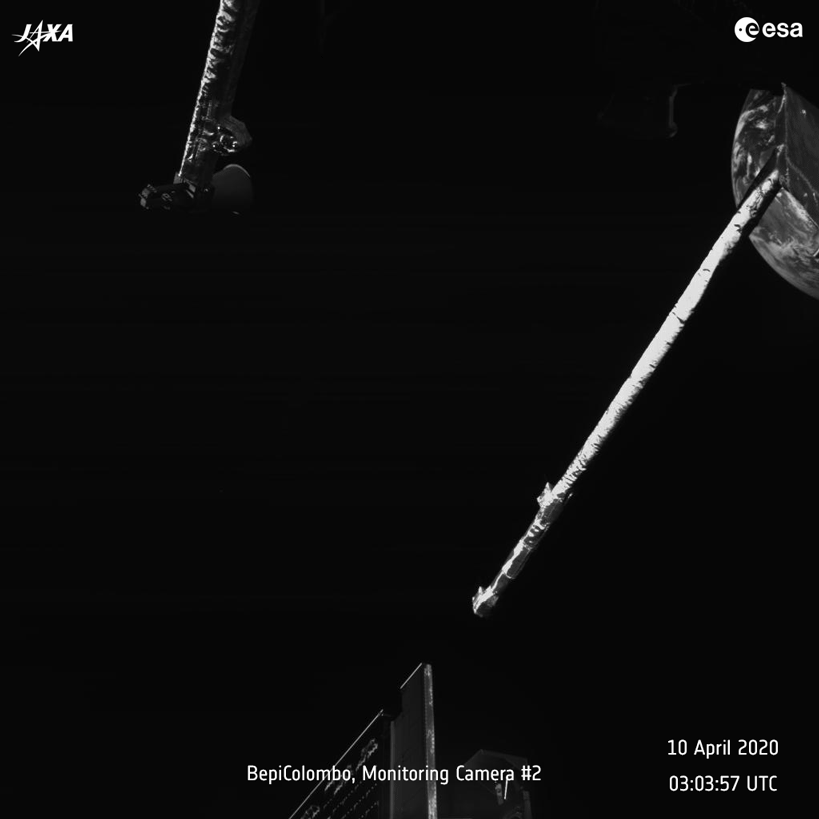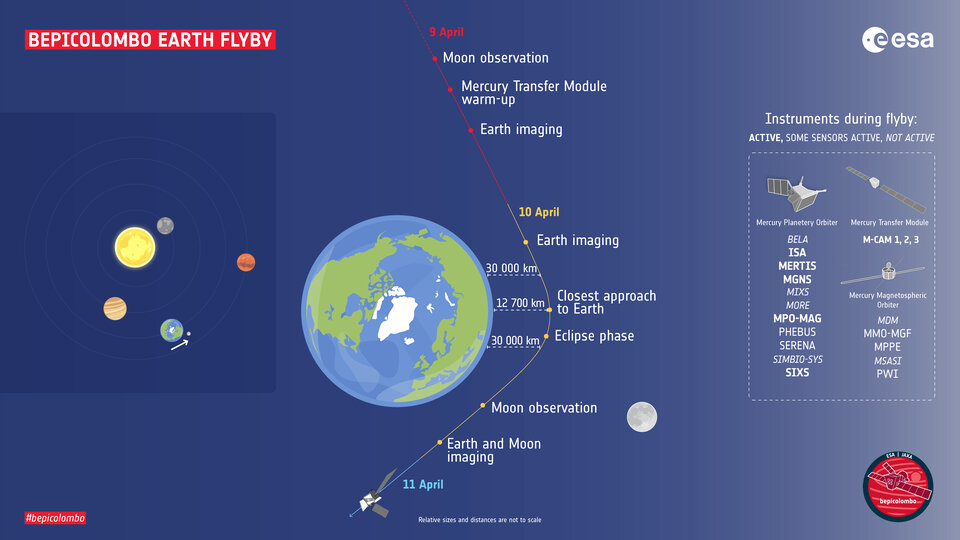
For SpaceUpClose.com & RocketSTEM
CAPE CANAVERAL, FL – The ESA/JAXA BepiColomo spacecraft just captured an eerie combination sequence of selfie and Earth images moving in the background as the robotic vessel was conducting a gravity assisted flyby of our home planet amidst the COVID-19 crisis gripping the planet to set the probe on the path to its ultimate destination – the planet Mercury.
“The ESA/JAXA BepiColombo mission completed its first flyby on 10 April, as the spacecraft came less than 12 700 km from Earth’s surface at 06:25 CEST, steering its trajectory towards the final destination, Mercury,” ESA announced in a press release.
“Images gathered just before closest approach portray our planet shining through darkness, during one of humankind’s most challenging times in recent history.”
BepiColombo is ESA’s first mission to Mercury and the Earth flyby was the first of 9 setting up the probes arrival at Mercury in December 2025.
The images were taken by one of three MCAM cameras aboard the Mercury Transfer Module. They provide black-and-white snapshots in 1024 x 1024 pixel resolution.
“These selfies from space are humbling, showing our planet, the common home that we share, in one of the most troubling and uncertain periods many of us have gone through,” said Günther Hasinger, ESA’s Director of Science, who also followed the event remotely from home, in Spain.
“We are scientists who fly spacecraft to explore the Solar System and observe the Universe in search of our cosmic origins, but before that we are humans, caring for one another and coping with a planetary emergency together. When I look at these images, I am reminded of the strength and resilience of humankind, of the challenges we can overcome when we team up, and I wish they bring you the same sense of hope for our future.”

ESA said that there were no negative impacts of the coronavirus pandemic on the success of the mission controlled in Darmstadt , Germany
“Space operations are never routine at ESA’s mission control centre in Darmstadt, Germany, but today’s flyby had one extra challenge. The manoeuvre, programmed long in advance and impossible to postpone, had to be prepared with limited on-site personnel, amid the social distancing measures adopted by the Agency in response to the ongoing coronavirus pandemic; but the restrictions had no impact on the operation’s success.”
The next two flybys will take place at Venus and followed by six more at Mercury itself before entering orbit at Mercury in late 2025.
Along the way during the cruise phase, several of the science instruments will be activated to gather measurements.
The flyby’s are essential to slowing down the spacecraft sufficiently to slip into orbit and be captured by the gravitational pull of Mercury.

“As BepiColombo swung by our planet, most scientific instruments on ESA’s Mercury Planetary Orbiter – one of the two science spacecraft that make up the mission – were switched on. Several sensors were also active on the second component of the mission, JAXA’s Mercury Magnetospheric Orbiter, also known as Mio,” said ESA.
“Scientists will use the data gathered during the flyby, which include images of the Moon and measurements of Earth’s magnetic field as the spacecraft zipped past, to calibrate the instruments that will, as of 2026, investigate Mercury to solve the mystery of how the scorched planet formed.”
The $1.9 Billion BepiColombo mission to Mercury lifted on Europe’s premier and most powerful rocket the Ariane 5 from Kourou, French Guiana on 19 October 2018 on on a seven-year journey to the smallest and innermost planet orbiting the Sun
BepiColombo is a joint endeavour between the European Space Agency (ESA) and the Japan Aerospace Exploration Agency (JAXA) and marks one of the most technically challenging missions attempted by both agency’s.
If all goes well, BepiColombo will become only the second mission to orbit Mercury, following up on NASA’s MESSENGER mission which explored the hellishly hot planet for four years from 2011 to 2015. However there are stlll many unanswered question like what is the composition of the material in the permanently shadowed polar craters- water ice and what else?
It also counts as Europe’s first mission to Mercury and the world’s first mission to send two spacecraft at once to the tiniest of the terrestrial planets. They must endure and survive extreme temperatures ranging from -180ºC to over 450ºC – hotter than a pizza oven!
“Many of the spacecraft mechanisms and outer coatings had not previously been tested in such conditions.”
The mission comprises a pair of orbiters- one contributed by each space agency that orbit Mercury from two different orbits and with two different sets of science instruments that will provide “complementary measurements of the planet and its dynamic environment at the same time.
BepiColombo comprises 4 elements – two science orbiters: ESA’s Mercury Planetary Orbiter (MPO) and JAXA’s Mercury Magnetospheric Orbiter (MMO, or ‘Mio’) – stacked on top of one another, as well as a sunshade and the Mercury Transfer Module (MTM).
The ESA-built Mercury Transfer Module (MTM) will carry the orbiters to Mercury using a combination of solar electric propulsion and gravity assist flybys.
MPO is equipped with 11 science instruments. MMO carries five science instruments.
They will fly in different elliptical orbits.
“A unique aspect of this mission is having two spacecraft monitoring the planet from two different locations at the same time: this is really key to understanding processes linked to the impact of the solar wind on Mercury’s surface and its magnetic environment,” says ESA’s BepiColombo project scientist Johannes Benkhoff.
Watch Ken’s continuing reports onsite for live reporting of upcoming and recent ULA and SpaceX launches including Boeing Starliner, Crew and Cargo Dragon, Solar Orbiter, In-Flight Abort and Starlink at the Kennedy Space Center and Cape Canaveral Air Force Station.
Stay tuned here for Ken’s continuing Earth and Planetary science and human spaceflight news: www.kenkremer.com –www.spaceupclose.com – twitter @ken_kremer – email: ken at kenkremer.com
Dr. Kremer is a research scientist and journalist based in the KSC area, active in outreach and interviewed regularly on TV and radio about space topics.
………….
Ken’s photos are for sale and he is available for lectures and outreach events



